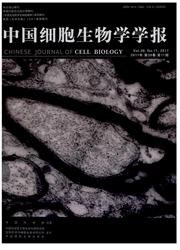

 中文摘要:
中文摘要:
DNA双健断裂(DNA doubled—strand breaks,DSBs)是目前已知DNA损伤中最为严重的一种,会造成遗传信息丢失,甚至细胞死亡。为了应对DSB损伤,生命体进化出DNA损伤应答(DNA—damage response,DDR)机制,进行损伤修复以防止错误遗传信息的传递。在这一过程中,作为染色质主要结构蛋白的组蛋白发生多种修饰,包括磷酸化、甲基化、乙酰化、泛素化等。这些组蛋白修饰促进DDR相关蛋白在DNA损伤处的招募,并改变染色质结构,以促进修复过程顺利进行。
 英文摘要:
英文摘要:
DNA doubled-strand breaks (DSBs) which is the most serious species in DNA damage can lead to the loss of genetic message or even cell death. To resist DSB damage, the organism has developed a DNAdamage response (DDR) mechanism for DNA damage repair to avoid the transfer of inaccurate genetic message. In this process, histone which is the main structural protein of chromatin is regulated by multi-modifications, such as phosphorylation, methylation, acetylation, ubiquitination and so on. These modifications of histones promote the recruitment of DDR-related protein to the site of DNA damage in the process of DNA damage repair, and change chromatin structure to facilitate repair progress in DDR.
 同期刊论文项目
同期刊论文项目
 同项目期刊论文
同项目期刊论文
 PTEN suppresses the oncogenic function of AIB1 through decreasing its protein stability via mechanis
PTEN suppresses the oncogenic function of AIB1 through decreasing its protein stability via mechanis FOXK2 Transcription Factor Suppresses ER alpha-positive Breast Cancer Cell Growth Through Down-Regul
FOXK2 Transcription Factor Suppresses ER alpha-positive Breast Cancer Cell Growth Through Down-Regul EGF is required for cardiac differentiation of P19CL6 cells through interaction with GATA-4 in a tim
EGF is required for cardiac differentiation of P19CL6 cells through interaction with GATA-4 in a tim Induction of the CLOCK gene by E2-ERalpha signaling promotes the proliferation of breast cancer cell
Induction of the CLOCK gene by E2-ERalpha signaling promotes the proliferation of breast cancer cell DEC1 regulates breast cancer cell proliferation by stabilizing cyclin E protein and delays the progr
DEC1 regulates breast cancer cell proliferation by stabilizing cyclin E protein and delays the progr Switching of the Triplet Excited State of Rhodamine/Naphthaleneimide Dyads: An Experimental and Theo
Switching of the Triplet Excited State of Rhodamine/Naphthaleneimide Dyads: An Experimental and Theo The relationship between the inflammatory response and cell adhesion on alginate-chitosan-alginate m
The relationship between the inflammatory response and cell adhesion on alginate-chitosan-alginate m Contributory role of five common polymorphisms of RAGE and APE1 genes in lung cancer among Han Chine
Contributory role of five common polymorphisms of RAGE and APE1 genes in lung cancer among Han Chine DACH1 inhibits SNAI1-mediated epithelial-mesenchymal transition and represses breast carcinoma metas
DACH1 inhibits SNAI1-mediated epithelial-mesenchymal transition and represses breast carcinoma metas 期刊信息
期刊信息
